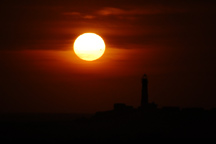

I did a fair amount of preparation for this at a time of frantic outside things - final exams, grade submission, visit from Kent and Barb from LA, stock market collapse, last-second buying and delivery of heavy foundation materials for the new Cabrillo Observatory building (and digging!)... So, it was a relief to actually have the long awaited day arrive, as I'd have a few days rest afterwards. My plan was for (CSU Professor) Chris Kitting (and students) and I to get the coveted shots. But, it all went quite differently than I'd envisioned. I did lots of work on preparing to image the setting sun over the San Francisco skyline's TransAmerica building (Golden Gate Bridge not possible). I paid some, but not enough, attention to the fact that part of the Marin headlands would be behind the northern part of San Francisco along with the sun. Many Google Earth images and azimuth line calc's selected a number of sites from Bay Farm Island on up to Garin Park and beyond.... but then Chris Kitting, on his bike, found that the Marin Headlands would backdrop most of the skyline. I rechecked, and found the 850 ft high Hawk Peak would wreck the shot, allowing only the top 1/3 of the Transamerica tower to poke above it against the sun from Bay Farm Island (where we'd need to port our gear 50yds from the parking lot to the beach). Turns out another photographer had the same idea, and if the clouds had cooperated, he'd have gotten some great shots I believe. None of the higher elevation sites in the Hayward Hills would see the sun against any of the SF skyline. This was discovered with just hours to go.
Meanwhile, Kirk Bender mentioned a few days earlier that he thought one could see the sun against the Pigeon Point Lighthouse from near the Gazos Creek parking lot, based on his observing the December total lunar eclipse there. I did the calc's and found the required precise spot looked pretty good - it was off Hwy 1 on the road to the parking lot, and had a clear view over flowery fields to the ocean and the lighthouse 2 miles away. The lighthouse I calculated would be 37 arc minutes high, vs. the 29 arc minutes for the sun; a nice, comparable scale. Fogcast showed clean skies all day, with perhaps a few wisps of cirrus late in the day. A few clouds would add to the scene, I thought, and it was a pretty good plan B. Chris was most concerned with getting some special UV imaging for a scientific question he's investigating, and the seeing at his home was no doubt going to be better than at Pigeon Point. So, reluctantly, our team was split up. My hastily assembled new plan was to go to Cabrillo College Observatory and get the ingress with my LIA Dave McKulle, along with some of my best students - Duncan and Becky. Then, Duncan would stay with Dave while Becky and I would continue on to the Santa Cruz Lighthouse to join the SCAC transit public viewing there, and then I'd continue on and meet Kirk at Gazos Creek for final imaging of sunset. Since the entire transit lasted over 5 hours for us Californians, this made for a long and enjoyable day, and it went very well.
First, our images from Cabrillo Observatory. I spent the day before the transit making a solar filter for the Megrez APO 80mm refractor, from spare mylar (left over from the stock sent by Walt Morgan for the annular eclipse 2 weeks earlier). As it turned out, I never used it.
Full size image through the 8" Meade w/ Thousand Oaks filter at f/10 focus w/ Nikon D40. Very faint halo on un-transited side of Venus is visible. |
The "black drop effect" - the apparent bridge between the dark Venus and the dark sky - is accentuated by poor seeing or focus, as early astronomers discovered. |
 |
The "black drop" at 2nd contact |
Even clearly after 2nd contact, there's a bit of black bridge trying to connect Venus to darkness
|
|
Actually, Becky's 1 yr old son was a real joy, full of curiosity, and I had a blast teaching him a ton of new words. Some day, he'll hear the cryptic words "pier blocks" echoing in his head and wonder where the heck they came from.
|
Destination: Gazos Creek; to photograph the sun with Venus still on the face, setting behind the historic Pigeon Point Lighthouse.
Site selections use C2A to run an azimuth line corresponding to the refracted position of the sun when it would silhouette the lighthouse. Proper Azimuth = 119.0 degrees from lighthouse |
Great photographers think alike. At least in this case. Like David Hartley, Jeanine Lovett, Kirk Bender and I. |
All, in quest, of Venus on the setting sun silhouetting the largest lighthouse on the west coast
|
 |
|
Note that Venus is "doubled" by differential refraction. |
Kirk Bender's Flickr page of beautiful photos of the afternoon transit are on the link. And his lunar eclipse shots of the night before are here.